The Ulus of Jochi is the land in the west of the Mongol Empire that Chinggis Khan granted to his eldest son, Jochi, in 1224. In turn, Jochi’s son Batu Khan conquered the Volga region, Russia, the Black Sea region, and the Caucasus for the Ulus, creating the largest state in medieval Europe. All the Kazakh khans can trace their ancestry back to Jochi’s descendants, and his ulus can rightly be considered the foundation of Kazakh statehood. This year, Kazakhstan celebrates the 800th anniversary of the Ulus of Jochi.
This is the second part of the history of the Jochi Ulus. The first part can be read here.
HOW THE HORDE NEARLY BECAME CHRISTIAN
After the death of Batu in 1255, who was then not yet fifty years old, his son Sartaq succeeded to the throne of the Ulus of Jochi. He was a Christian, and it was thanks to him that the first church was established in Sarai. At this point, the Tengrian Horde could well have become Christian. After all, there were vast Christian lands in Russia under their authority, whose princes were frequent guests in Sarai, forming alliances as they needed. Taking these circumstances into account, it is difficult to imagine how the history of Eurasia would have unfolded at that point!
However, we know nothing of Sartaq’s plans, with Rubrouck doubting the sincerity of his faith. Having found Sartaq to be a prince, he tells us that Sartaq asked him to find a master skilled in the production of parchment. Apparently, Sartaq wanted to establish book production in Sarai. Not hiding his annoyance, the traveler pedantically lists everything the prince had extorted or simply taken from him: some church vestments and paraphernalia, a luxurious psalter, ‘a Bible translated into verses, a book in Arabic worth 30 bezants,i
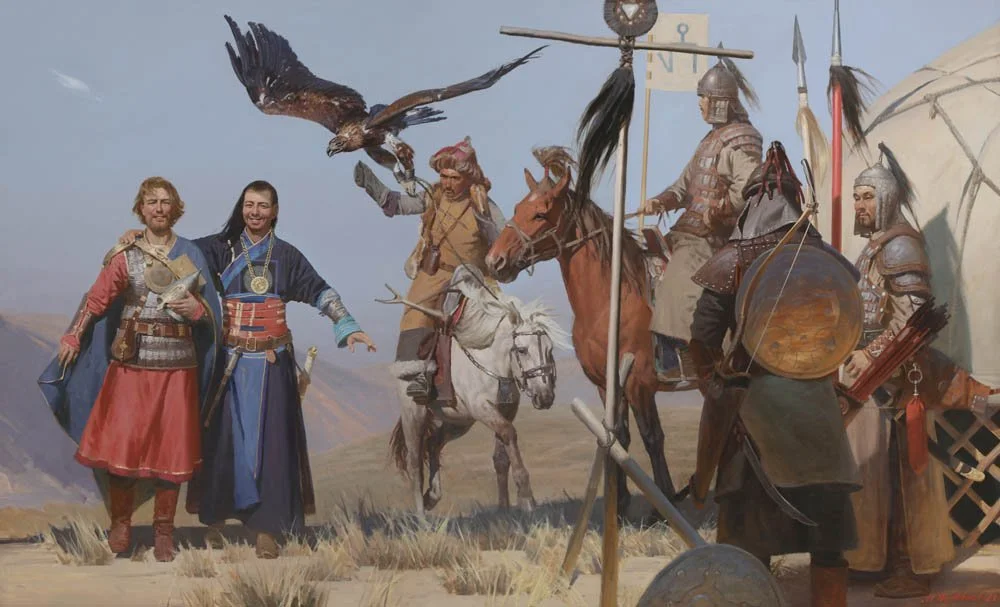
Poletaev M.A. Sworn brothers. Alexander Nevsky's meeting with Sartak in 2021. Oil on canvas.
However, none of this did Sartaq much good. He died soon after his proclamation as khan, likely being poisoned, and then his young son Ulaghchi died, probably from the same cause as well. Boraqchin Khatun, Batu’s widow, observed by both Plano Carpini and Rubrouck, served as regent under the unfortunate Ulaghchi, and made every effort to retain the power to which she had long held on to.
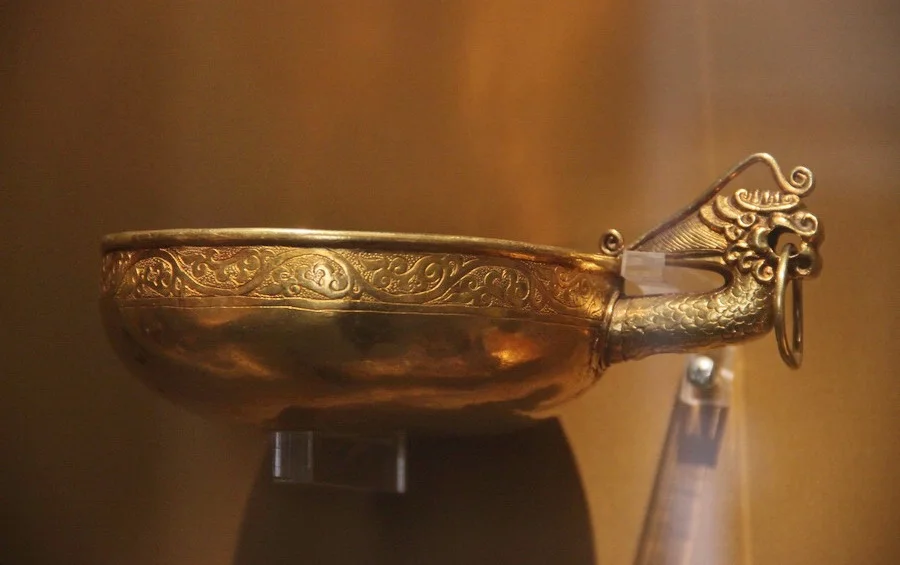
The belt bucket. Gold, Ulus of Jochi of the 13th century/The State Hermitage Museum/https://maximus101.livejournal.com
CLEOPATRA OF THE STEPPES
Boraqchin is the first prominent khatun (female counterpart of the khan) in the history of the Golden Horde. An Arabic author remarked: ‘She possessed a great mind and the ability to command.’ Some accounts suggest that Boraqchin was the wife of Ögedei Khan, the emperor of the Mongol Empire. After his death, she fled to Batu, lived with him, and after Batu’s death, she married his son Tukan. Sartaq may be the son of Boraqchin (though there is no evidence to support this). In any case, this steppe Cleopatra was both wife and stepmother to Tukan.
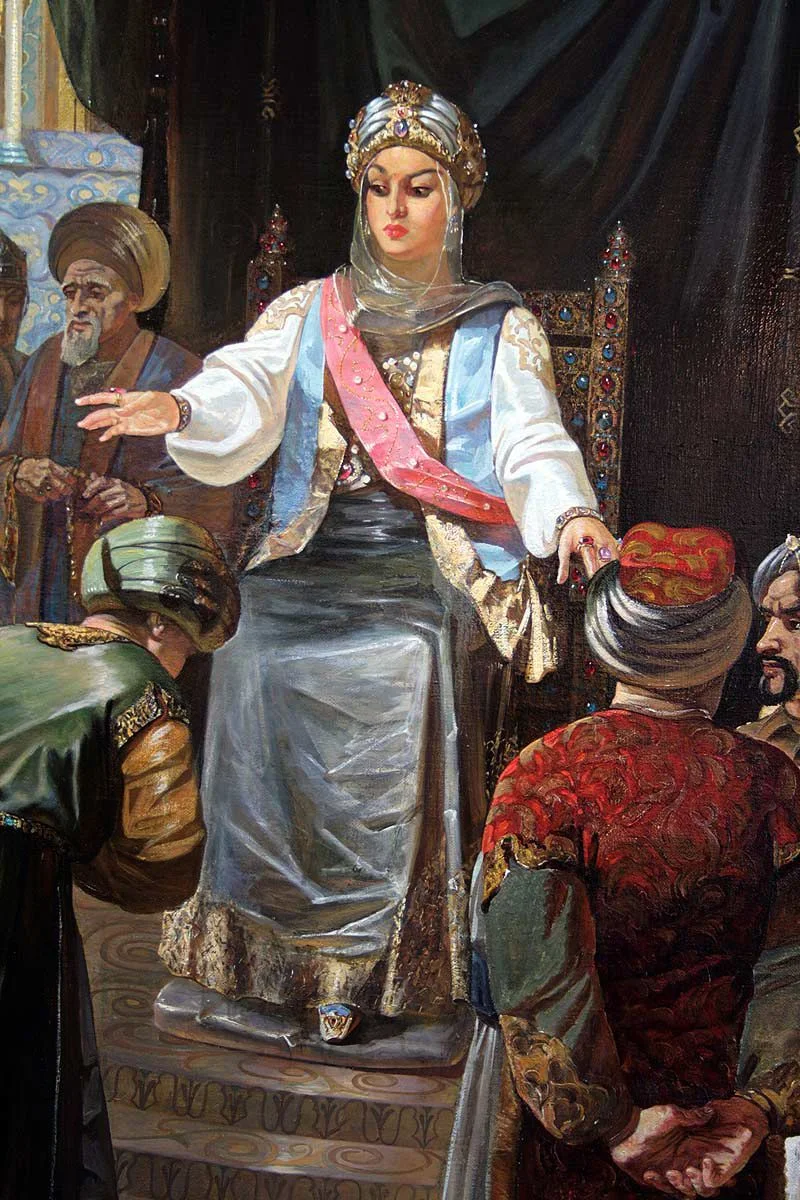
Borakchin/from open access
After the sudden death of Ulaghchi, the furious khatun wanted to enthrone her son by Tukan, and she decided to rely on the support of the Horde’s worst enemy—Hülegü, the ruler of the Ilkhanate. It is said that she sent him an arrow without feathers and a caftan without a belt, adding these words: ‘There is no arrow left in the quiver and the shoulder is without a bow, come and accept the kingdom.’ Unable to wait for an answer, which would have taken several months to come back, the khatun went to Hülegü herself. During her journey, she was killed by Berke's men, who was Batu’s brother. It's likely that Berke was also responsible for the deaths of Sartaq and Ulaghchi.
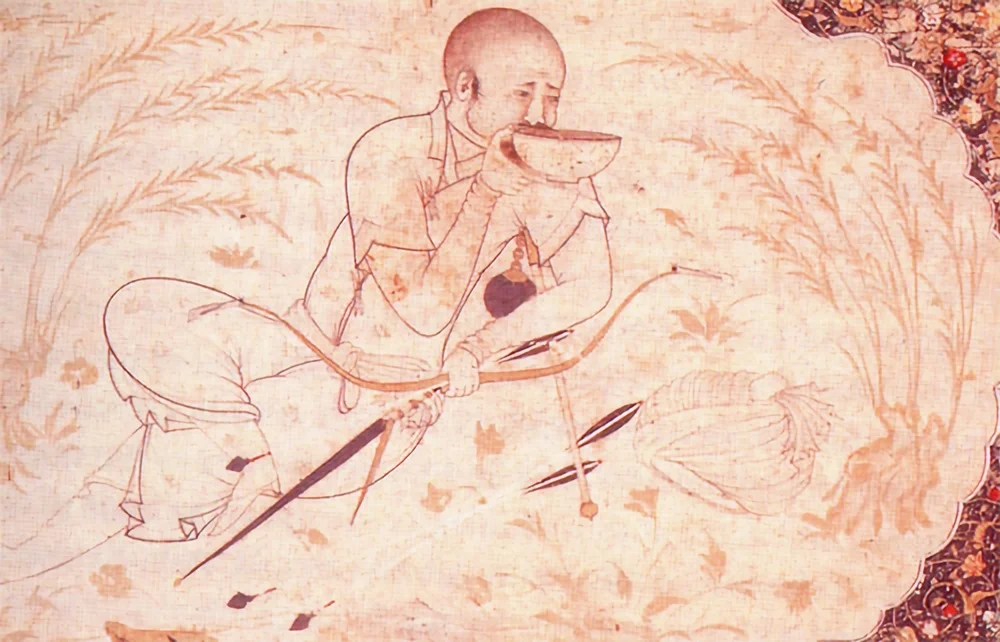
he il-Khan Hulagu rests. From a medieval manuscript/British Museum.
The scenario of this first dynastic crisis would repeat itself over and over again with different variations. The unlimited power of the khan was an irresistible temptation, and poison or murder was an easy way to rise to the top of the world overnight. All one needed was to belong to the sacred clan of Chinggis Khan. The conspirators could be the elders in the family like Berke. Experienced, skilled, surrounded by loyal followers, they had undeniable advantages over the younger people in the clan. However, the throne was often seized by the young and the bold. In the end, it was the most determined and, of course, the cruelest who gained power. It was a similar story in many monarchies, both in the West and in the East, until a fixed order of succession was established. There was a small nuance typical only of the Horde, though. A woman here could have been stronger than a man and overpower everything—Boraqchin was simply unlucky.
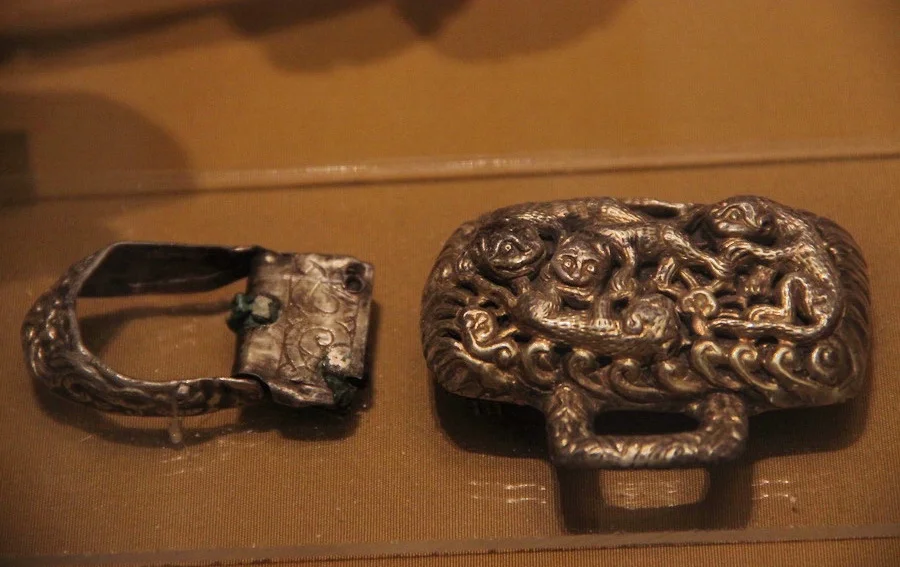
Belt set. Gold. Ulus of Jochi, 13th-14th centuries./The State Hermitage Museum/https://maximus101.livejournal.com
FRIEND OF THE FAKIR SHEIKHS
The next crisis occurred in the early 1280s, with a character quite unusual for the Chingisids. Tode Mongke, Batu’s grandson, ascended the Khan's throne, and he was zealously interested in Islam. This was nothing new: the first Muslim on the throne of the Horde was Khan Berke, but Tode Mongke’s fervor was overwhelming. He was strongly influenced by Sufism, which preached everything the khan had no use for: renunciation of carnal pleasures, vanities, poverty, and mercy.

Socrates and the disciples. Arabic miniature of the 11th century/Topkapi Museum
Moreover, such a set of values was simply dangerous for a ruler. Meanwhile, Tode Mongke, according to the fourteenth-century Arab historian Ibn Khaldun, ‘became a hermit and renounced the kingdom; he devoted himself entirely to the community of fakir sheikhs’. As a result, the khan was declared insane and overthrown in 1287. As the fourteenth-century Persian historian Waṣṣāf al-Ḥaḍrat colorfully described it, ‘As a result of his dissoluteness … they put him away like a gold coin out of circulation, at the bottom of the resignation purse.’

A bronze pot. Ulus of Jochi. The Bulgar settlement of the 13th century./The State Hermitage Museum/https://maximus101.livejournal.com
A FAT ONE-EYED DOG
At this point, a very important new character enters the politics of the Great Horde. We already know that the empire was easier to create than to maintain. With the vast distances involved, even taking the reliability of the postal service into account, the supreme rulers were more dependent and relied more on their viceroys.
Nowadays, we get annoyed if we don't get a reply to a message within a minute, but imagine if you had to wait two or three months for a reply. This would be okay if you only want to know how things are—though a long wait for a response would undoubtedly be unpleasant. But what if we were talking about important political decisions? For better or worse, the supreme rulers had to grant their viceroys almost unlimited freedom. In the Horde, such viceroys were called tümen-ü noyan, or commanders of the tümens.
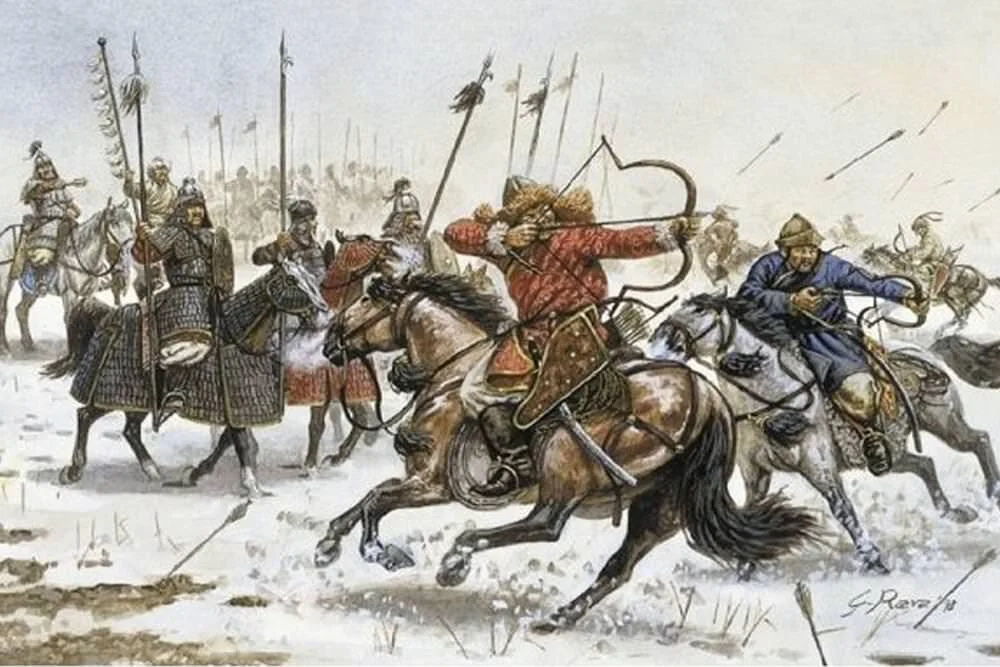
From open access.
Over time, some tümen-ü noyans gained enormous power by gathering local elites around themselves, creating new ones, and meddling with their neighbors. This allowed them to accumulate impressive social capital as well as real material capital. If they were healthy, viceroys held their positions longer than many supreme rulers. As a result, they often looked down on the musical chairs played by the change of khans in Sarai, which, considering the pace of events during that era, seemed like they were happening on Mars. In addition, the ruler’s earthly journey often ended faster than the news of his accession reached the far reaches of the Horde. And to be fair, the khans did not want to get involved in the intricacies of life in a place that seemed as far as Alpha Centauri—they had enough worries of their own.

Silver paiza of the 14th century. The sign of supreme authority, which the khan issued to the commissioners. Ulus of Joschi of the 13th-14th centuries/The State Hermitage Museum/https://maximus101.livejournal.com
School textbooks today frown upon the idea of ‘feudal fragmentation’. But the negative perception of fragmentation began to emerge only at the time of the formation of modern, centralized states in Europe, beginning about the fourteenth to fifteenth centuries. The centralized monarchies were eager to appear in the shining garb of progress, which overcame any previous discord.
In fact, ‘fragmentation’, or the breaking up of a large state created by the impulse of a charismatic personality, was quite natural for the world of that time. Not only empires but also kingdoms and even principalities were shredded until they reached comfortable, manageable proportions, where the authorities could literally look into every cauldron and reach into every purse. The economy of the time, which often brought the population to the brink of starvation, could not afford to maintain an extensive bureaucracy, police force, or public education system that would inculcate patriotic ideals in the young. As a result, the central government was forced to trust provincial rulers, who soon began to feel completely independent. It must also be said that small states or quasi-states were much more effective at providing security and maintaining order than large ones.
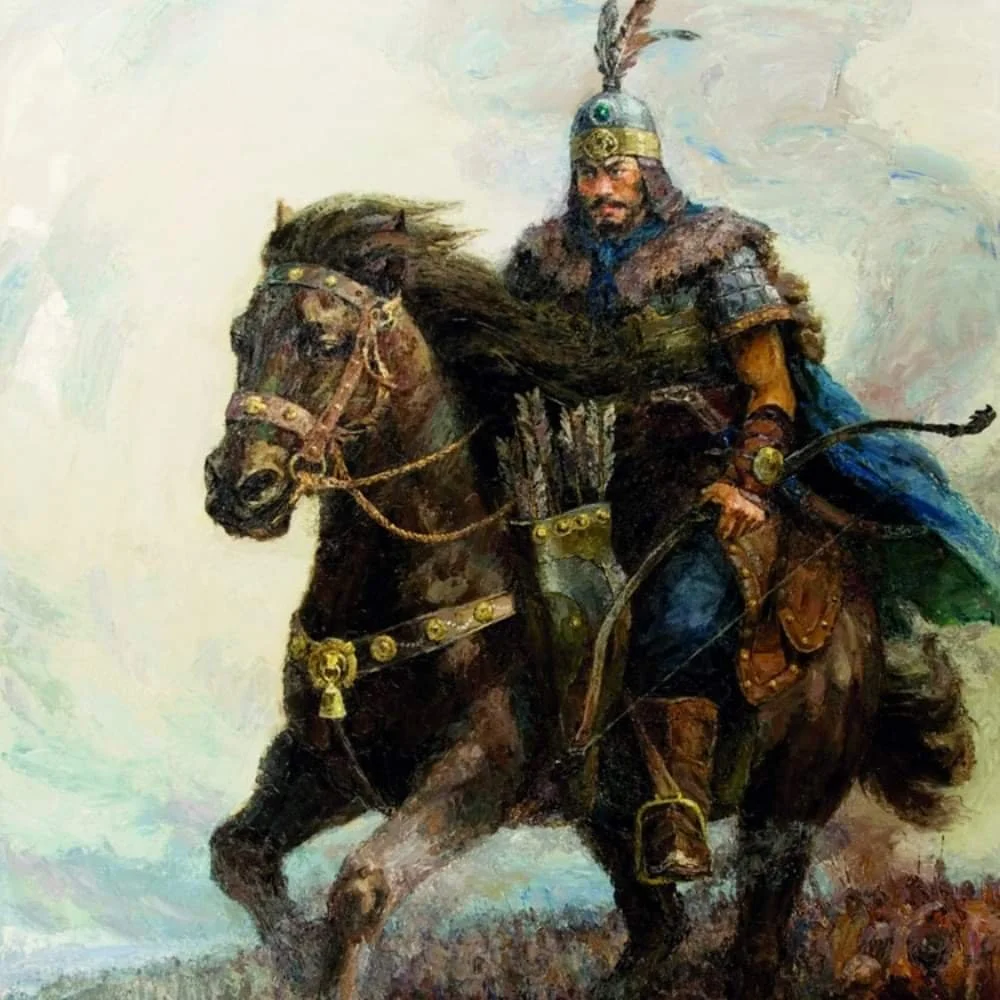
From open access.
This is how the tümen-ü noyan Nogai (1235–1299) appeared in the Horde. He was the military governor for the khan and had almost unlimited authority over the southwestern provinces of the empire. He emerged as one of the most powerful overlords of Eastern Europe in the second half of the thirteenth century. It is believed that it is he who was depicted in a Russian epic under the name ‘Kalin Khan the Dog’. Kalin means ‘fat’ in Turkic, and nogai means ‘dog’ in Mongolian. However, the people of the steppe loved dogs, and this nickname was hardly an insult to Nogai at home. The laudatory eulogies of the Secret History of the Mongols1
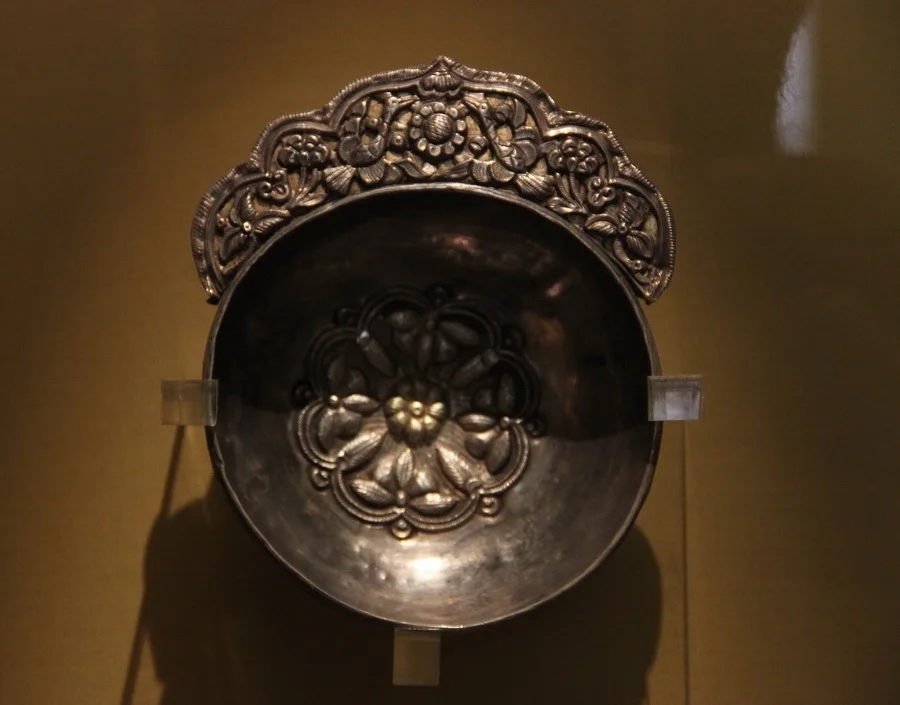
Belt bucket, silver. Jochi Ulus, 13th century/The State Hermitage Museum/https://maximus101.livejournal.com/
Nogai was a brave warrior, an excellent commander, and an industrious individual. He roamed the northern coast of the Black Sea, systematically expanding his territories. He controlled Bulgaria and Serbia, the kingdom of Galicia-Volhynia, keeping the rulers of Hungary apprehensive. He attacked Poland and Lithuania, trying to wrest control of the Russian principalities from Sarai, conducted secret negotiations with Venice, and fought with Byzantium. The Basileus2
Nogai was Chingisid, but he came from a distant branch and could hardly expect to take the throne. He probably wanted to become the informal ruler of the empire. After the pious Tode Mongke was overthrown, Nogai and the new khan had a strained relationship. Each thought the other was too independent, which made them both unhappy. It is not clear who wanted to kill whom first, but Nogai proved to be the faster of the two.
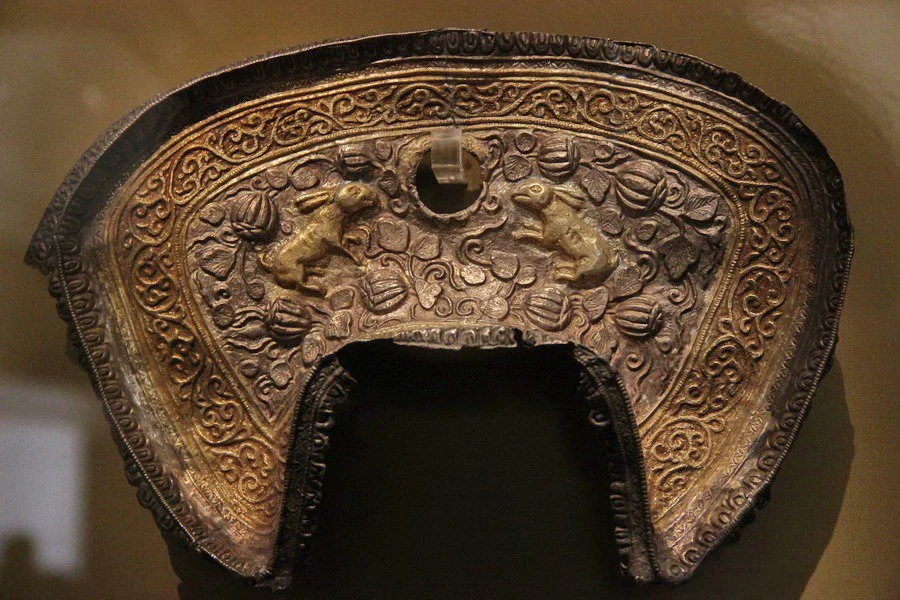
Saddle pads. Ulus of Jochi, 13th-14th centuries./The State Hermitage Museum/https://maximus101.livejournal.com/
The throne went to the murdered man’s cousin, Toqta. And Nogai, who had paved his way to power, hoped for cooperation but in vain. Khan Toqta had no intention of being the puppet of his tümen-ü noyan. A cautious and calculating man, Toqta saved his strength and finally engaged in battle with Nogai—and he lost. In his victory, Nogai did not behave like a Chingisid. Perhaps he did not have enough of the ruthless conqueror’s blood in him, and he let Toqta go. Two years later, in 1299, Toqta returned and defeated Nogai, resulting in the mighty tümen-ü noyan’s death. According to legend, he was killed by a Russian warrior (the Horde had many of them). But when the Russian brought Nogai’s head to Toqta, expecting a generous reward, Toqta ordered the execution of the commoner who had dared raise his hand against a Chingisid. As we can see, Toqta had his fair share of Chinggis Khan’s blood.

https://centr-intellect.ru/
The memory of the imperious Nogai was apparently kept alive by the Nogai Horde, which rose on the ruins of the Golden Horde at the end of the fourteenth and the beginning of the fifteenth century. It is believed that the foundations of the Nogai tribe consisted of the elites that were once united by the Horde’s tumen-ü noyan. Thus, his memory is still alive today, both in the name of the ethnicity—there are about 100,000 Nogais—and in the name of the whip popular in the steppe regions.
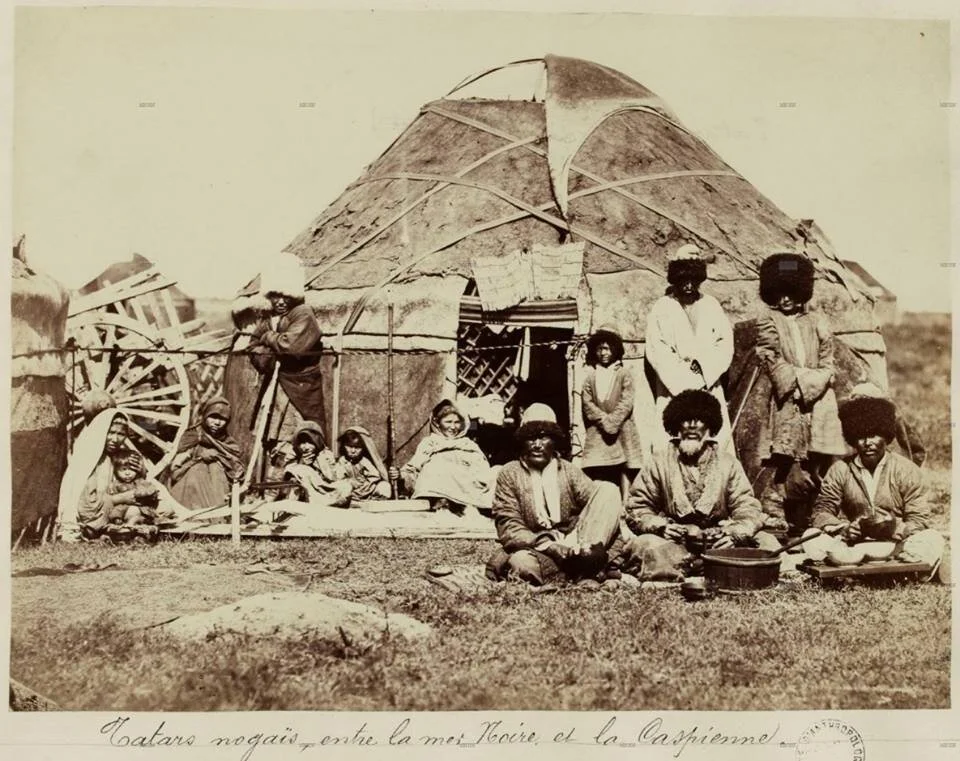
Nogais/from open access
THE GOLDEN AGE
Under Toqta’s nephew, Özbeg Khan (1313–41), the Horde, as we recall, became golden. Özbeg was a Muslim, like Berke or Tode Mongke, but religion was a matter of politics rather than personal choice for him. The Horde under Özbeg became a Muslim country, and Islamization was an important tool for the consolidation of its various elements.
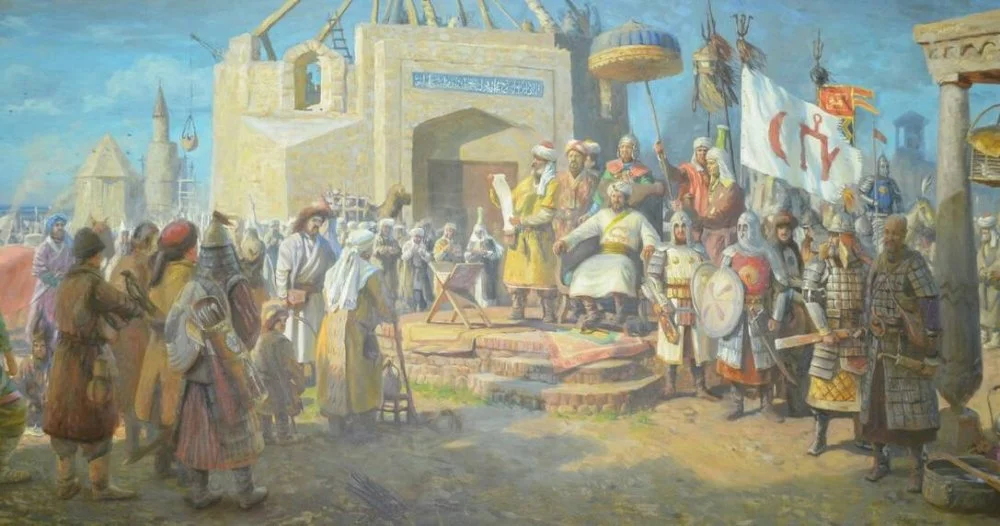
I.K. Akzhigitov. The adoption of Islam in the Golden Horde in 1312-1313. 2018/Penza Library named after M.Y.Lermontov
Özbeg hoped to use Islam to unify his power, and as we would say today, to develop a common cultural code for his people. A new, Islamic version of the legitimacy of the Chingisids, admittedly quite an extraordinary one it must be said, emerged. Allegedly, Chinggis was converted to Islam by one of the Prophet’s companions, though he was never circumcised.
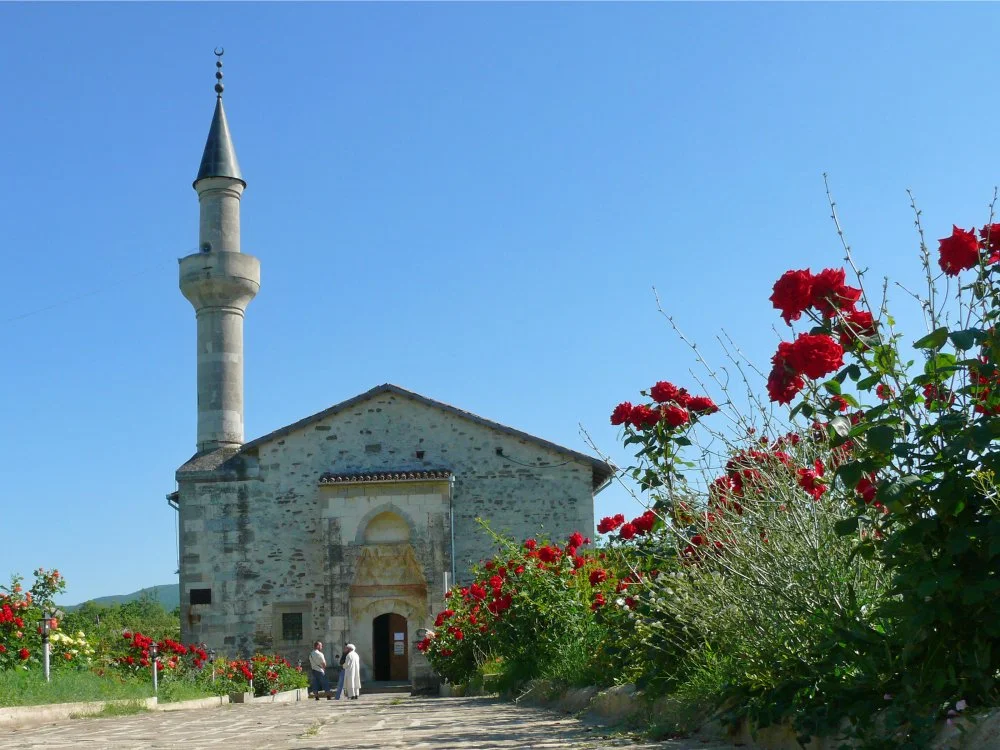
Uzbek Khan Mosque, built in 1314 in Stary Krym, Crimea./Piotr Matyga/Wikimedia Commons
On the one hand, the Ulus of Jochi united many ethnic groups including the Mongols and various Turkic tribes. On the other hand, it did not represent a unified spiritual and cultural space. Some strategically important areas, such as Khwarazm or Volga Bulgaria, had long been Muslim. At the same time, other pre-Mongol peoples of the Ulus were familiar with Islam thanks to the influence of Muslim preachers along the trade routes. In addition, Muslim officials from Khwarazm played an important role in the administration of the empire. There were many merchants and craftsmen of different faiths in the large cities, but Muslim missionaries—Sufis and dervishes (from the tariqas of Yasawiyyah, Qalandariyyah, Kubrawiyya, etc.)—were especially popular there. In close proximity, encircling this world from all sides, was the most important pillar of the Horde's power, the military nomadic tümens and thousands, where Tengrism was the predominant belief.
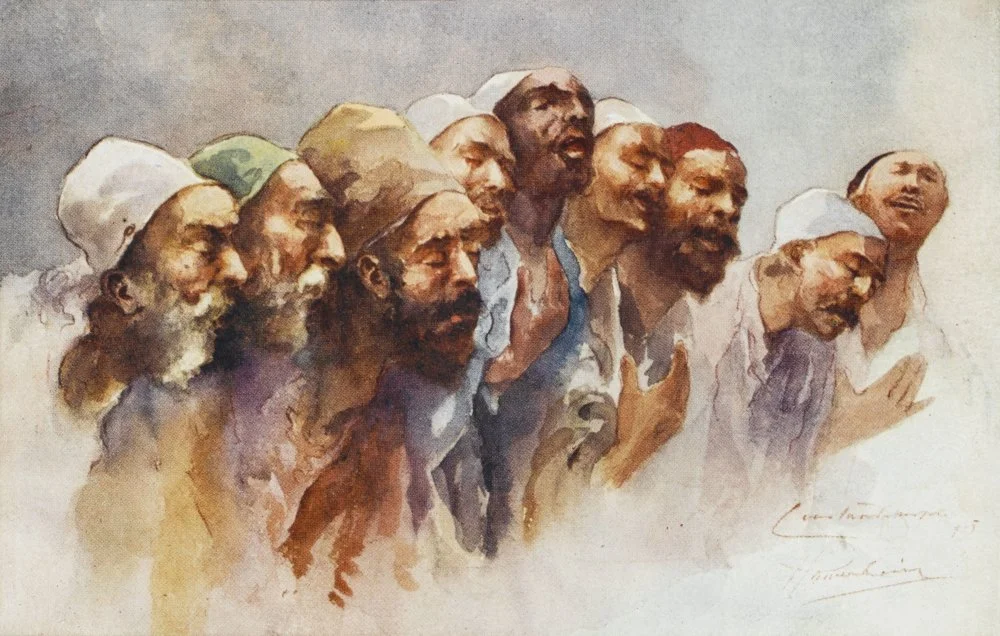
DERVISHES OF DIFFERENT SUFI ORDERS ENGAGED UPON ZIKR/Superstock
Around the same time, in the eastern part of the Ulus of Jochi, Islam became the state religion in the 1320s. It was introduced by Khan Erzen (Ilbasan). He moved the capital of the Ak Orda to Sighnaq, built mosques and madrassas, and apparently erected a Muslim mausoleum of Jochi in Ülytau. However, for a long time, Islam remained the religion of the elite and the cities, with very little influence on the mindset of the main masses of the nomads, who continued to honor their gods.

Rustem Pasha Mosque by Jean-Léon Gérôme/Wikimedia commons
Özbeg Khan was certainly a religious man but not a fanatic. Nor was he particularly militant. His long reign was relatively peaceful and seems to have been quite happy. Trade caravans crossed the empire unhindered, noisy caravanserais were full of guests, and no one feared bandits or famine.
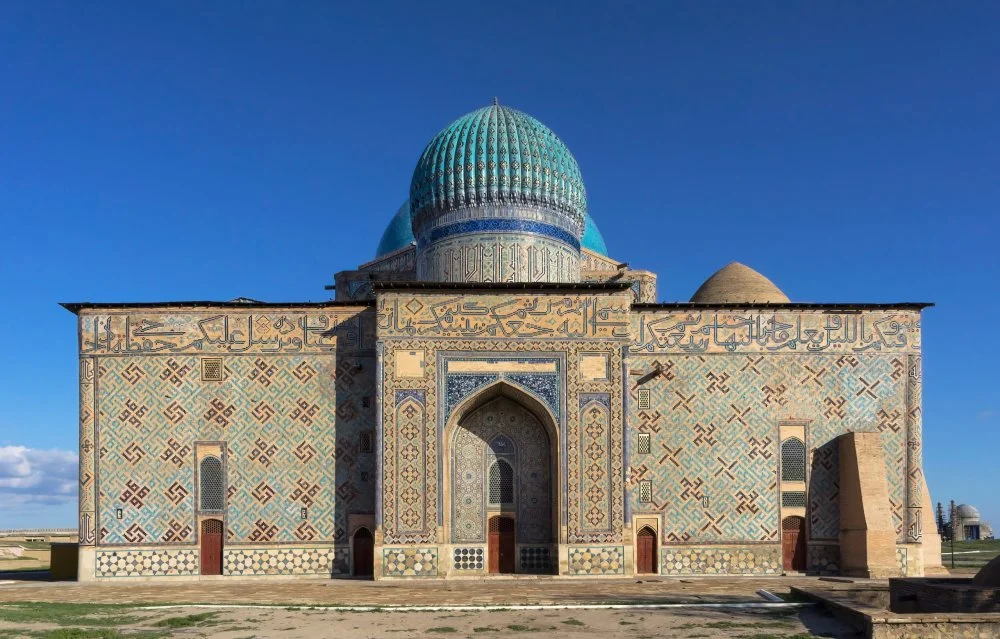
Mausoleum to Khoja Ahmad Yasawi (UNESCO World heritage site), Hazrat-e Turkestan, Kazakhstan. Prime example of Timurid arhcitecture with bigest Dome in Central Asia/Petar Milošević/Wikimedia Commons
In fact, any Golden Age is the worst time for historians. The more prosperous and peaceful life is, the less work a historian has. So let’s then turn our attention to the extraordinary woman who was Özbeg’s companion, because she certainly deserves it. It is noteworthy that her high status remained unaffected by the official adoption of Islam.
THE FATEFUL KHATUN
Özbeg’s first and principal wife was Taydula Khatun. Ibn Battuta reports: ‘As for Taytugla,i

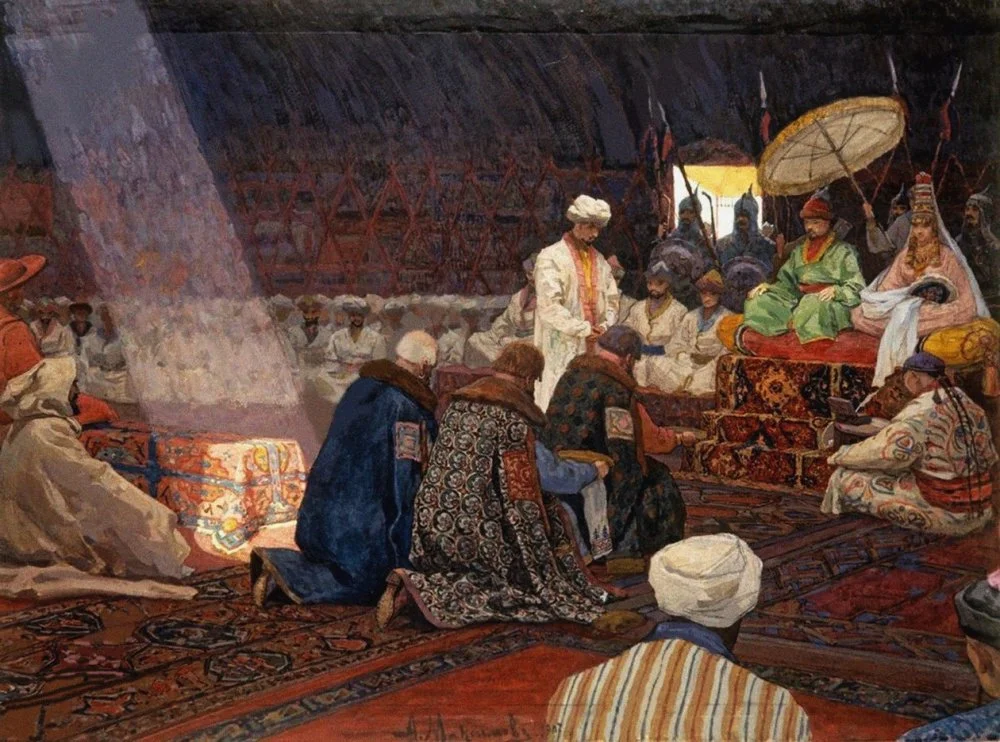
A. F. Maksimov. In the Golden Horde. 1910s/Heritage Images
Prone to providing racy reports, Ibn Battuta goes on to say: ‘He spends most of his nights with her.’ Clearly trying to find an explanation for the khan’s scandalous behavior, he conducts a full investigation. And here a ‘reliable source’ reports that the queen is somehow a virgin again every night. Another claims that her ‘uterus’ looks like a ‘ring’ as is the case for certain special kinds of women—Ibn Battuta himself never met them, but they can certainly be found in China. All these juicy details point to one thing: the high position of women in the Horde seemed shocking to outsiders, and they often tried to find the most fantastic reasons for it. As far as we know, the power of women was not limited to the khan’s yurt. Turkic epic songs are full of vivid and strong images of women. In the steppes, mausoleums are built over the graves of female ancestors and beloved women.
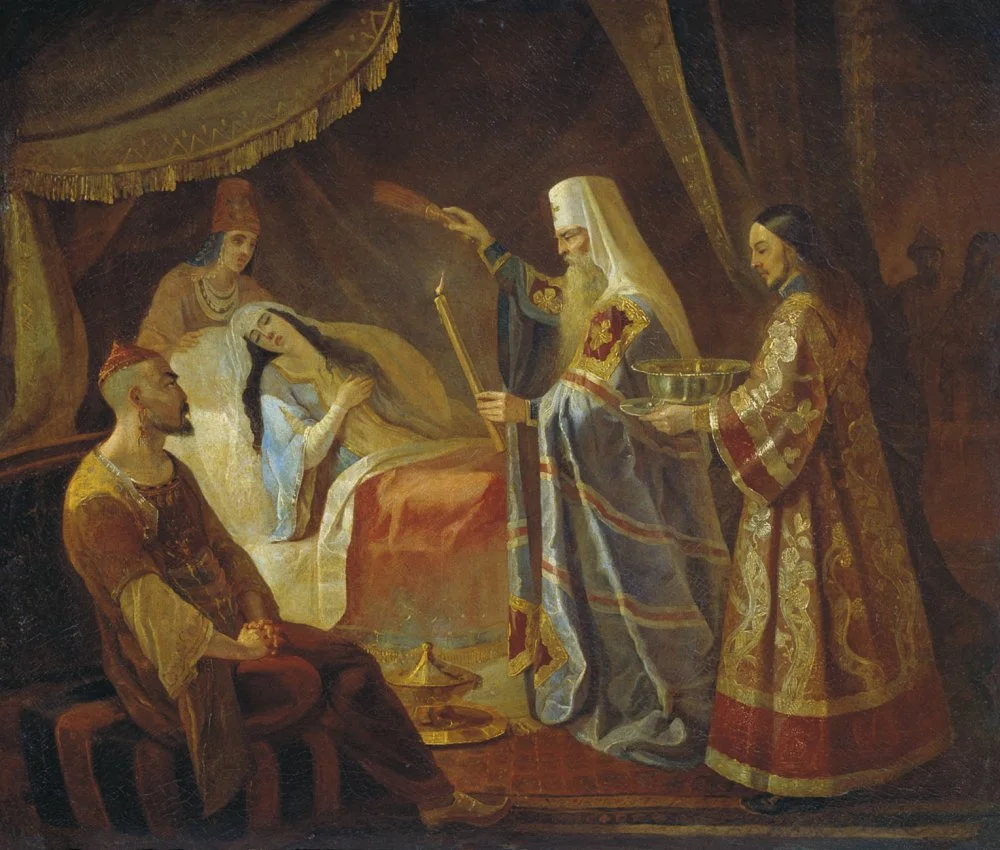
Yakov Kapkov. Healing by Metropolitan Alexei Taydula/Tretyakov Gallery /Wikimedia Commons
The twelfth-century writer Muhammed al-Idrisi testifies: ‘Their women are beautiful, have more endurance than men, and are more enterprising in obtaining what they need because of their energetic nature and proud character.’ Other eyewitnesses reported that steppe women were warlike, riding horses, shooting arrows, and were less likely than men to run from the enemy in battle.

Bulat Gilvanov. The Bulgarian warrior Altynchech (Goldilocks)/from open access
Even in this context, Taydula stands out, resembling, one might say, Shakespeare’s Lady Macbeth. After Özbeg’s death, Taydula decided to keep her hand on the reins of state power. She organized the murder of a dangerous pretender to the throne, the son of Özbeg’s other wife. In all likelihood, she also had her own son Tini Beg killed in order to place her favorite son, Jani Beg, on the throne. However, in the midst of the tales of Taydula’s dark deeds, a beautiful legend suddenly pops up. Allegedly, the khatun was suffering from an eye disease and invited Alexius, the Metropolitan of Kiev and all Rus, to the Horde to cure her. The Metropolitan was armed not only with prayer but also with medical skills. The khatun was cured, and the metropolitan was generously rewarded. In honor of this event, the Chudov [Miracle] Monastery was founded in the Kremlin. However, historians believe that perhaps it was not the khatun who was ill, but Jani Beg—and this illness may have been mental. Alexius alleviated his suffering, but the khan died soon after. However, a version of the story goes that he was killed by his own son Berdi Beg. Either way, with the death of Jani Beg in 1357, peaceful life in the Horde ended forever.

Khan Janibek. The Catalan Atlas. 1375 © National Library of France
If Berdi Beg really did kill his father, Taydula could have been involved, and what her motives were can only be guessed. Berdi Beg was vengeful and cruel. He slaughtered twelve of his relatives, including infants, but was still killed by another prince. It is believed that in 1359, with the death of Berdi Beg, who ruthlessly destroyed his kin, the Batu dynasty ceased to exist and the throne passed to another branch. This was probably the immediate cause of the country’s slow descent into a deep and bloody crisis. In the west of the Horde, there were simply no direct descendants of Jochi who would enjoy universal recognition.

Berdibek sits on the Horde throne. 1568/ Лицевой летописный свод/Alamy
The new khan removed Taydula from power. However, she did not accept this and organized a conspiracy to kill the khan and all his sons. She installed a certain Navruz as the ruler, who was perhaps her grandson or possibly her lover. This time, however, the Tatar nobles united against her, and in 1361, Navruz, his entire family, and the great khatun herself were killed. Thus ended twenty years of almost unlimited power for this remarkable and very cruel woman.

The murder of Berdibek. A Russian medieval miniature. 1568/Illustrated Chronicle of Ivan the Terrible/Alamy
THE GREAT TROUBLES
Meanwhile, the Horde continued to fall into a prolonged crisis marked by endless coups and internal strife known as the Great Troubles. For twenty years, from 1360 to 1380, twenty-five khans sat on the throne in quick succession. Because the central power was shaky, trade came to a standstill, income from dependent lands plummeted, and peripheral territories—Khwarazm, Bulgaria, Mordovia, the Black Sea region, and the Crimea—began to fall away. Some lands were taken over by local nobles, others by various Horde commanders. Their neighbors did not sleep either. In 1362, the Lithuanian army invaded the lands of the Horde in an unprecedented manner. In the Battle of Blue Waters—fought on the Syniukha River, a tributary of the Southern Bug in the south of present-day Ukraine—the Grand Duke of Lithuania Algirdas (1345–77) defeated the Horde and captured Podolia (southwestern Ukraine). Of course, only the local Jochid warlords fought the Lithuanians, but it was still a shame to be defeated in one’s own domain. It was clear that the Golden Horde was shrinking and losing power.

Period of Golden Horde (Ulus Jochi). 13th-14th c. Helmet with a half-mask, eye slits and nose guard. Iron, gilding. The State Hermitage Museum. Saint Petersburg. Russia/Alamy
The most remarkable figure of the period was undoubtedly Mamai (circa 1335–1380), a hero of that time of troubles. Russian sources mistakenly called him a khan. In fact, he was not of very prominent origin. In those times, being Jochid was perhaps even dangerous, and the life expectancy of a descendant of Chinggis Khan was quite short. However, it was the time of people like Mamai, brave, adventurous people who managed to rise from the lowest ranks.
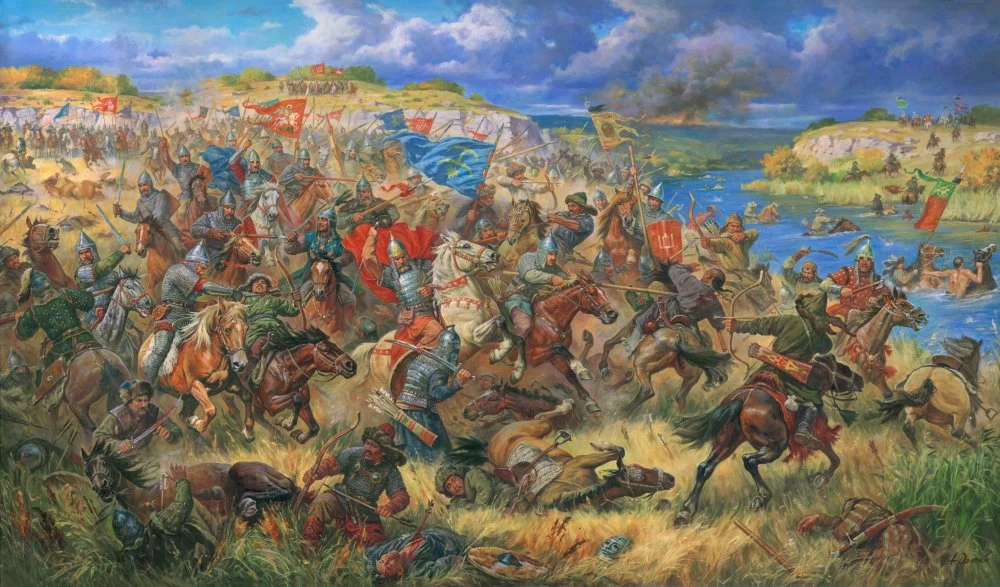
A.O. Orlenov. The Battle of the Blue Waters/https://archive.com/en/
Mamai consolidated a powerful but marginal ulus around himself—the Black Sea steppes and the Crimea. At that point, many nations were gaining independence. Unlike them, however, Mamai did not lose sight of the empire. As a tümen-ü noyan, he married well—his bride was the khan’s daughter—and became a gürkan, the khan’s son-in-law, and the beklerbek. It was probably impossible for a non-Jochid to rise higher in the empire. Mamai preferred to rule the empire through puppet Khans. But chaos would soon consume both them and him.

V. Matorin. Mamai/https://archive.com/ru/
Unexpectedly, the representative of the eastern wing of the Horde, Urus Khan—from whom the Kazakh khans are directly descended—appeared on the stage. Moreover, the Nogai beys called the Kazakh khanate ‘Urus Yurt’, and it is likely that it was Urus Khan who became the prototype of the mythical Alash Khan, the founder of Kazakh statehood.
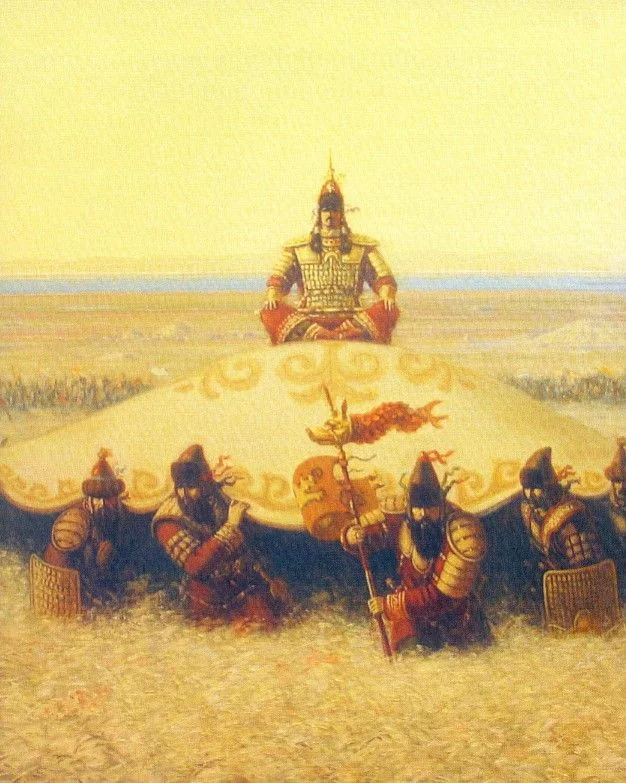
Alash Khan/From open access
Shortly after taking the throne in 1368, Urus Khan killed the governor of Sarai and began minting his own silver coin to assert his claim to supremacy, including over Sarai. After the massacre carried out by Berdi Beg, there were no strong Jochids left there. ‘He was a very grumpy, strong, and powerful king,’ wrote one historian of Urus Khan.

Urus Khan Silver Coin/https://en.numista.com/
He fought for power over Sarai with varying degrees of success, going as far as to conquer it once, but victory eluded him each time. His main rival in the west was, of course, Mamai. However, the winner of this confrontation was the enemy of both men— Tokhtamysh, who was a Chingisid, albeit a rather third-rate one.
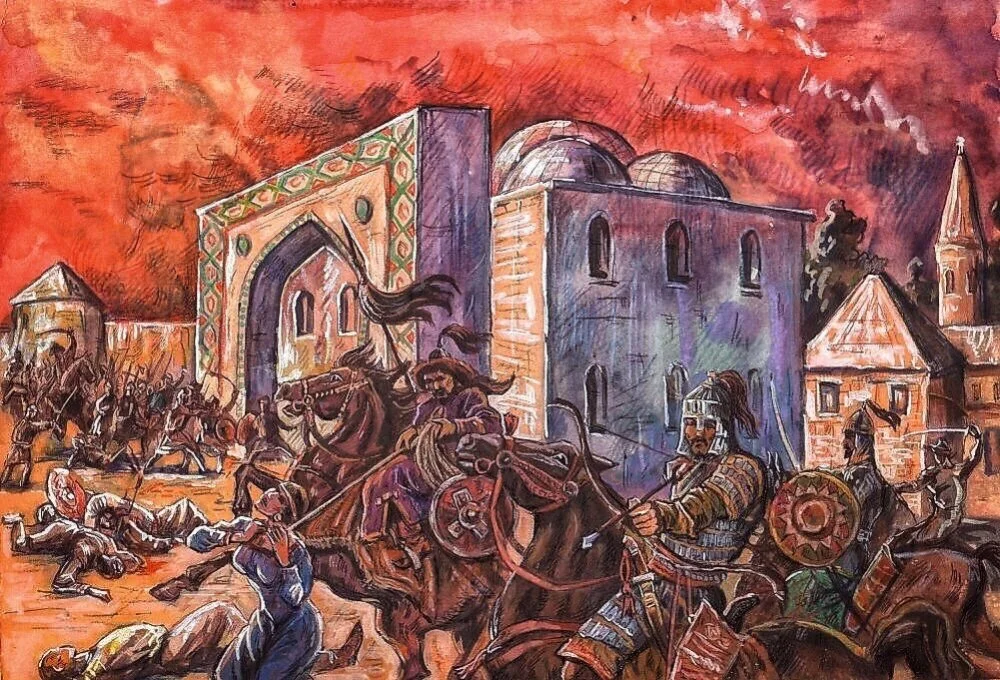
O. Leontiev. Again, the discord between Kazan and Crimean Tatars in Kazan.
At an earlier time, Urus Khan murdered his father, the regional ruler of Mangystau, prompting the young Tokhtamysh to seek protection from Timur, and the lame conqueror treated the young man well. Muin al-Din Natanzi reports that ‘Timur made indescribable efforts to honor him’, giving him ‘many royal tents and ornaments, along with horses and clothes’. He even gave him a yurt bigger and better than his own.
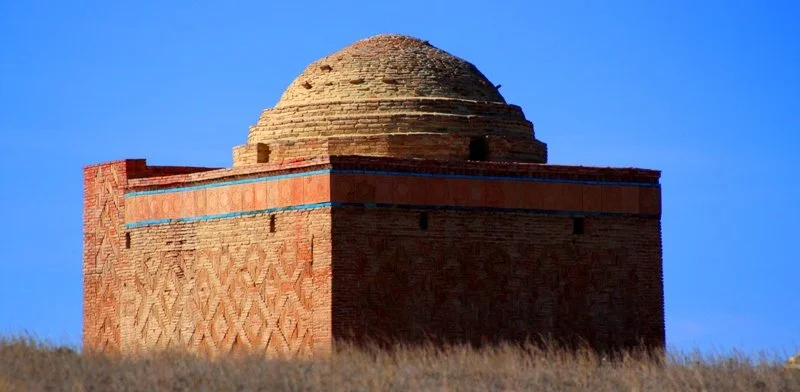
Mausoleum of Alash Khan. S. Malshybai. Ulytau region, Kazakhstan/https://qazaqstan3d.kz/
Rulers like Timur, however, rarely do things out of the goodness of their hearts—especially since the great conqueror was a chess player and calculated his moves far in advance. Apparently, Timur saw the young and hot Tokhtamysh as a bombard, a cannon (they were just starting to appear on battlefields) that would blow the first line of the Horde’s fortifications to smithereens. And then, leisurely, staggering on his wounded leg, he himself, the great Emir and the ‘Sword of Islam’, would swoop in.
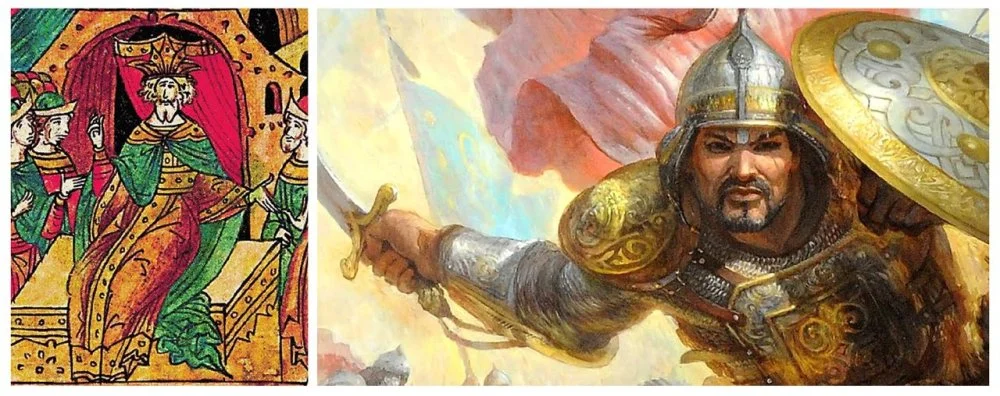
This is how the chroniclers saw Tokhtamysh, but this is most likely how he really looked.
Supported by the troops of the mighty Timur, in the 1370s, Tokhtamysh tried several times to seek revenge against his father’s murderer, Urus Khan, but failed each time. In the last battle, despite being wounded twice, he threw himself into the river, hoping to swim away. However, Urus Khan’s best knight shot him with an arrow, piercing four joints. But Tokhtamysh somehow survived and hid in the reeds for three days, diving headfirst into the water whenever he heard the pounding of hooves. Later, incredibly, Timur's doctors helped him regain the use of his legs.

Arrowheads for heavy bow shooting. Ulus of Jochi, 13th-14th centuries./The State Hermitage Museum/https://maximus101.livejournal.com/
In the end, the death of Tokhtamysh’s father would remain unavenged. Urus Khan would die in 1377 in a place called Kyshtym (possibly the Kyshtym River in the Chelyabinsk Oblast). His death made things easier for Tokhtamysh. This time, with virtually no resistance, he first subdued the eastern wing of the Horde and then advanced to Sarai. Tokhtamysh entered the capital in 1380. However, he was in no hurry to attack Mamai.
At that time, Mamai was in the Black Sea steppes, preparing for a campaign against Russia, which had taken advantage of the Great Troubles to act boldly and refuse to pay tribute. The situation, though, was somewhat ambiguous. Was Moscow in conflict with the Horde? That is, with Tokhtamysh, who was now in Sarai? Or was it still a conflict with Mamai? Typically, Eastern sources say nothing about the Battle of Kulikovo in 1380. For them, it was probably only one episode in the larger confrontation between Tokhtamysh and Mamai. After all, the Moscow prince Dmitry Ivanovich (Dmitry Donskoy (1359–1389)), who moved his army against Mamai, objectively acted in Tokhtamysh’s interests
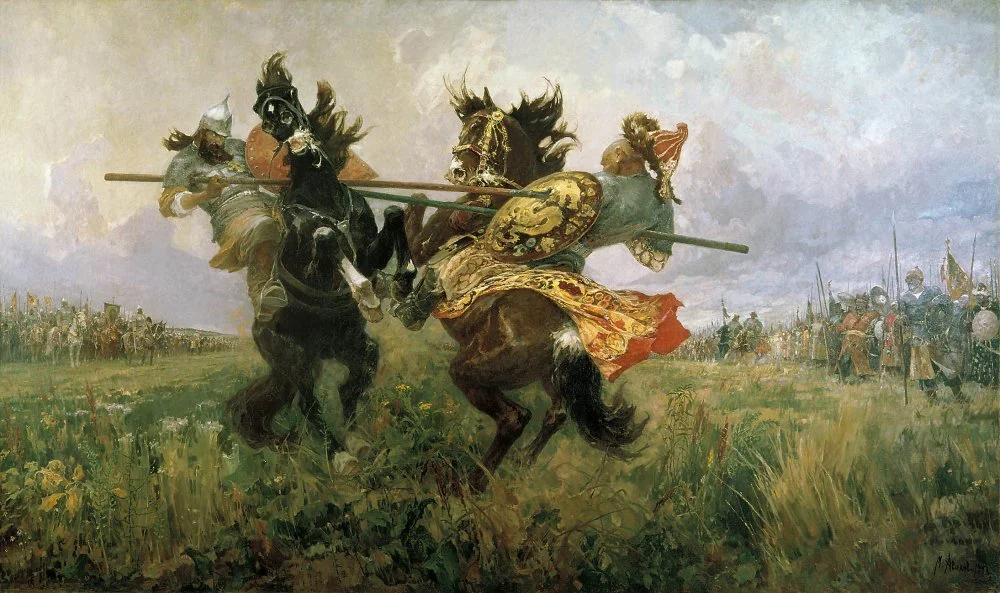
Michael Avilov. Duel between Peresvet and Chelubey on the Kulikovo field 1943/WIkimedia Commons
However, we have no evidence of any collusion between Tokhtamysh and the Moscow prince. Mamai was defeated on the Kulikovo Field by the army from Moscow, and the remnants of his army were crushed by Tokhtamysh on the banks of the Kalka River. The beklerbek fled to Caffa, where he was killed by the Genoese, who probably wanted to appease Tokhtamysh for their soldiers’ participation in the Battle of Kulikovo on the side of the usurper. But as soon as Tokhtamysh sacked Moscow in 1382, he resumed collecting tributes and brought Russia back into complete submission. From this point of view, it is unlikely that Tokhtamysh agreed to any compromise with Moscow. Rather, he was simply unsure of the outcome of the Battle of Kulikovo and decided to keep his hands free for himself. After all, if Mamai had defeated Moscow, everything could have turned out differently—the undefeated beklerbek would have been a force to be reckoned with.
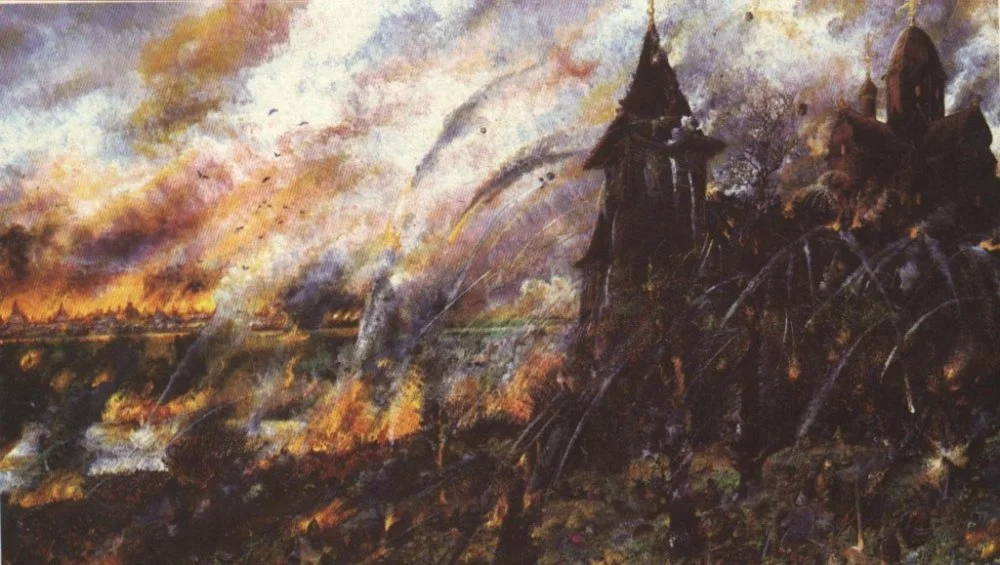
V. Smirnov. Moscow. The year is 1382. Siege of the monastery by Tokhtamysh. 1986.
THE END OF HISTORY
Timur once said of Tokhtamysh: ‘He was like a son to me, and I was like a father to him.’ Paradoxically, Tokhtamysh, barely established on the throne of the Horde, began to attack his former benefactor in Azerbaijan and the cities along the Syr Darya. In response, Timur conquered Urgench, the capital of Khwarazm, which would never return to its former greatness. In 1395, he attacked the Volga region. Deprived of its fortress walls, Sarai was sacked and destroyed. At this time, Timur probably decided not only to deal with the treacherous Tokhtamysh but also to return the Silk Road from the Ulus of Jochi to his territories, so to speak, to its former state. In the end, both Samarkand and Bukhara were under his rule. He advanced in Iran and Iraq and came close to Syria, from whose port cities the road continued to Europe.
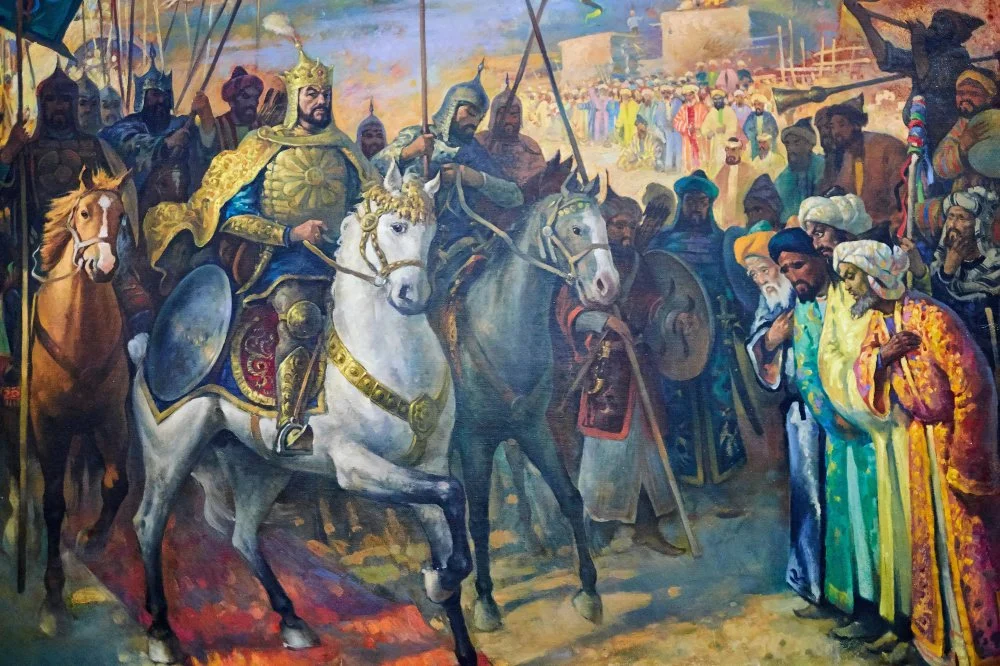
Tamerlan museum, fresco, Tamerlan coming down to the town/Alamy
In this final stage of the Golden Horde’s history, a character who was destined to become the most popular hero of the steppe epic suddenly appears—Beklerbek Edigu of the Mongol Manghud tribe, an ancestor of the Russian princes Yusupov. Urus Khan also executed Edigu’s father, and Edigu, like Tokhtamysh, fled to Timur, hoping to take revenge on Urus Khan with his support. At first, Edigu fought together with Tokhtamysh, but their paths soon diverged sharply. Tokhtamysh killed Edigu’s stepfather, gaining a fierce enemy for the rest of his life. When Tokhtamysh began to attack Timur, Edigu emerged as the most ardent advocate of retaliation against the treacherous khan and spent the rest of his life fighting Tokhtamysh and his children. Beklerbek Edigu was at the epicenter of the Horde’s downfall, just as his descendant, Prince Felix Yusupov, the murderer of the tsar’s favorite, Rasputin, would find himself in the maelstrom that swept away the Russian Empire many centuries later.
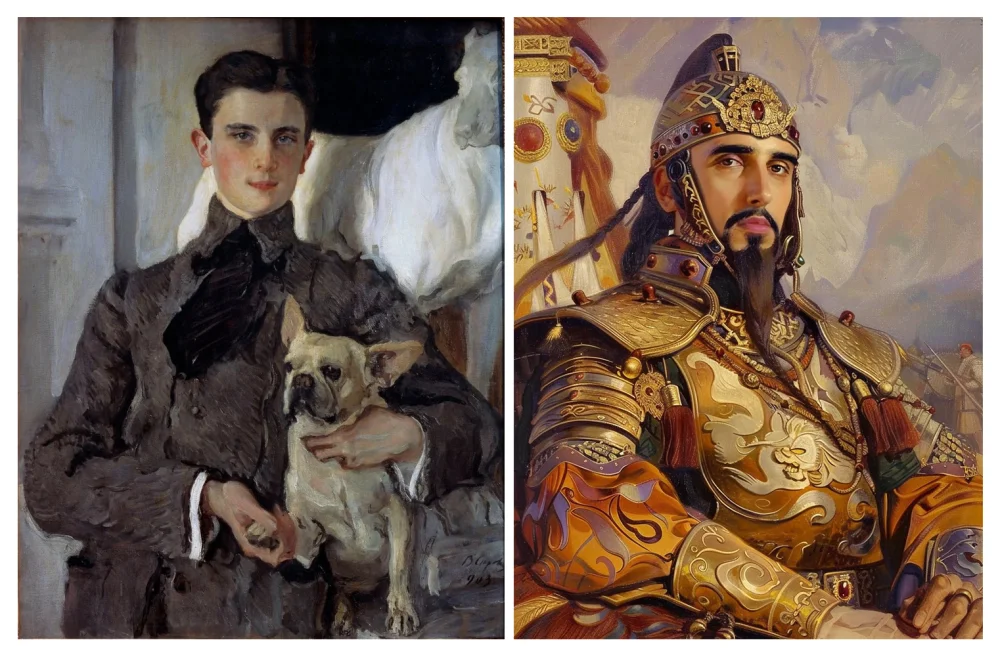
Portrait of Felix Yusupov by V. Serov and the image of his ancestor Edyge in the imagination of AI.
The Ulus of Jochi would never recover from Timur's attack, although Khan Tokhtamysh, who had brought this misfortune upon his country, tried long and unsuccessfully to rectify the situation until, according to legend, he died in 1406 at the hands of Edigu’s son, who would himself would also perish in this turmoil in 1419. The agony of the Ulus of Jochi would continue for several more decades, and new khanates would rise from its ruins. In 1502, the Crimean army, which had been separated for a long time, would defeat the headquarters of the last official khan of the Ulus of Jochi, bringing us to the end of the story.
EPILOGUE
The Golden Horde emerged as a result of conquests as did many other states before and after the Mongols. The unmatched military might, which suddenly appeared in the heart of Eurasia, inspired both fear and respect. Over the ages, the history of the Golden Horde has been recounted in various forms. For some, it marks the period of the formation of unique statehoods, while for others, it signifies a period of tragedy. Recently, Kazakh President Qasym-Jomart Toqayev attempted to find a third, reconciling perspective on the Golden Horde. He compared it to the Roman Empire, which, despite being founded through wars, became the bedrock of a new civilization and continues to serve as an inspirational cornerstone for European culture to this day. Whether one agrees or not, the Golden Horde created a new political and cultural reality, catalyzing the formation of numerous present-day states not only through conquest. The Ulus of Jochi exported advanced administrative practices from China and Central Asia, maintained a postal service that strengthened connections among peoples separated by thousands of miles, facilitated the prominence of Turkic as a language of international relations, and served as a bridge between the East and the West for an extended period of time, fostering the global exchanges of goods and ideas. We should also consider other features of the Golden Horde, which were very rare for that time, such as unprecedented religious tolerance, respect towards women, and acceptance of their independence. For all of these reasons, the 800th anniversary of the Ulus of Jochi, or the Golden Horde, is a significant milestone in Eurasian history.
Read the first part of the history of the Jochi Ulus here.
REFERENCES
Акимбеков С.М. История степей: феномен государства Чингисхана в истории Евразии. — Алматы, 2021.
Вернадский В.В. Монголы и Русь. — Тверь-Москва, 2001.
Греков Б.Д., Якубовский А.Ю. Золотая Орда и ее падение. — М., 1998.
Джованни Плано Карпини, Гильом де Рубрук (Рашид-ад-Дин, Ибн Баттута, Иоганн Шильтбергер). Путешествия в Золотую Орду. — М., 2021.
Золотоордынская цивилизация. — Казань, 2008–2009. Вып. 1–2.
Мыськов Е.П. Политическая история Золотой Орды (1236–1313). — Волгоград, 2003.
Насонов А.Н. Монголы и Русь. История татарской политики на Руси. — Л., 1940.
Сафаргалиев М.Г. Распад Золотой Орды. — Саранск, 1960.
Султанов Т.И. Чингиз-хан и Чингизиды. Судьба и власть. — М., 2006.
Темиргалиев Р. Казахи. Путь предков. — Алматы, 2021.
Тизенгаузен В.Г. Сборник материалов, относящихся к истории Золотой Орды. Т. 1. — СПб., 1884. Т. 2. М.-Л., 1941.
Трепавлов В.В. Государственный строй Монгольской империи XIII в. (проблемы исторической преемственности). — М., 1993.
Трепавлов В.В. История Ногайской Орды. — М., 2002.
Трепавлов В.В. Золотая Орда в XIV столетии. — М., 2010.
Федоров-Давыдов Г.А. Общественный строй Золотой Орды. — М., 1964
